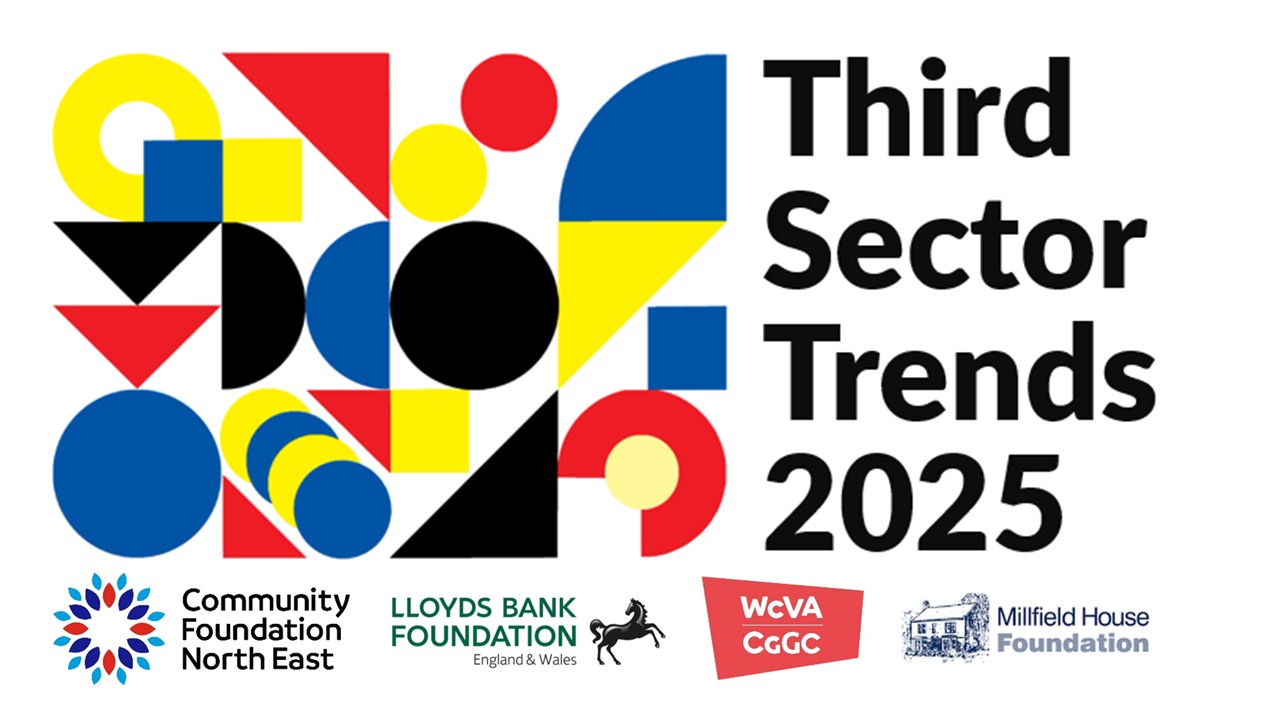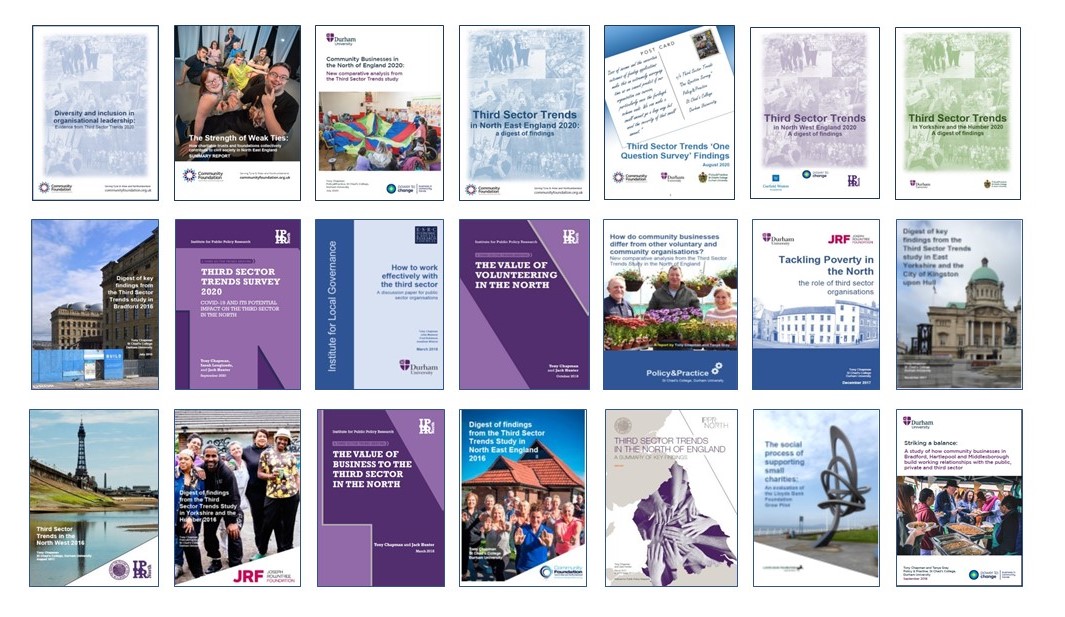
The study is live on June 2nd from 5.00am – please take part by clicking here: Third Sector Trends in England and Wales 2025
Third Sector Trends was initiated in 2008 by Northern Rock Foundation in North East England and Cumbria as a longitudinal study to explore the structure and dynamics of the sector in the context of change. The study now covers the whole of England and Wales
Third Sector Trends study was conceived and originally commissioned by Northern Rock Foundation with research conducted by the universities of Durham, Southampton and Teesside. The Community Foundation North East was a co-founder of the research and is now responsible for its legacy. Since 2012, the research programme has been run by Policy&Practice, St Chad’s College, Durham University. Its geographical coverage has expanded, first to the whole of the North of England in 2016 and then to England and Wales in 2019.
The study was established to look at structure, resource, purpose, practice and impact of the Third Sector from an independent and as far as possible, an ‘objective’ point of view. As such, the study collects and analyses quantitative and qualitative data to explore issues of interest to government, local public sector and health organisations, the private sector, grant making foundations, Third Sector infrastructure organisations at national and local levels and, of course, individual TSOs (see list of how interested stakeholders below have commissioned work below).
In 2025 the study is being supported by The Community Foundation North East, Lloyds Bank Foundation England and Wales, Wales Council for Voluntary Action and Millfield House Foundation.
Where you can find the reports
An archive of research reports is available on this website for each phase of the research programme. Third Sector Trends Publications Archive
All of the reports from the latest iteration of the study in 2022 can also be located here: Third Sector Trends in England and Wales 2022.
Research methods, ethics and data privacy
As a longitudinal study, Third Sector Trends is committed to maintaining a high level of academic integrity and research ethics. The most recent report on research methods can be located here: Third-Sector-Trends-Research-Methods-2022
We get a lot of support from local CVSs and Community Foundations with the study. Here is a brief summary of how they can help us in this work. Third Sector Trends in England and Wales 2025 – Information for VCSE infrastructure organisations (April 2025)
The current statement on ethics and data privacy (May 2025) can be found Third Sector Trends statement on research ethics, personal privacy and data usage (May 2025).Third Sector Trends statement on research ethics, personal privacy and data usage (May 2025).
A version of the privacy policy in Welsh is available Third Sector Trends statement on research ethics personal privacy and data usage (Welsh version, May 2025).
Organisations which have supported the study
The Community Foundation and St Chad’s College have collaborated with many partners over the years to fund core fieldwork and analysis, including:
- Barrow Cadbury Trust
- Charity Bank
- Economic and Social Research Council
- Garfield Weston Foundation
- Joseph Rowntree Foundation
- Lloyds Bank Foundation England and Wales
- Millfield House Foundation
- Power to Change
- Wales Council for Voluntary Action
Many commissions have also been awarded to undertake further analysis of the Third Sector Trends data by local authorities, health authorities, community foundations, think tanks and so on, as shown below:
- Buckinghamshire, Oxfordshire and Berkshire West NHS Integrated Care Board
- Clinks, His Majesties Prisons and Probation Service
- Cumberland Council
- Cumbria Community Foundation
- Durham County Council
- Essex Community Foundation
- Institute for Public Policy Research (IPPR)
- Kernow NHS Clinical Commissioning Group
- Kirklees Council
- Law Family Commission for Civil Society/Pro Bono Economics
- Lloyds Bank Foundation England and Wales
- NHS Humber and North Yorkshire Health and Care Partnership
- NHS South Yorkshire Integrated Care Board
- NHS West Yorkshire Integrated Care Board
- North East Local Enterprise Partnership
- Northumberland County Council
- Sheffield Council for Voluntary Service
- South Yorkshire Mayoral Combined Authority
- Sport England
- Stockton Borough Council
- Sunderland City Council
- West Yorkshire Combined Authority
- Westmorland and Furness Council
- Yorkshire Sport Foundation
History and purpose of the study
The study has grown in size as it had developed beginning with surveys of 1,000 respondents in 2010 in North East England and Cumbria to over 6,000 responses across England and Wales in 2022. As the approach to analysis of Third Sector Trends data has evolved, it has sought to produce findings which complement rather than replicate the findings of other major long-term studies.
The most important of these is the NCVOs annual UK Civil Society Almanac. Third Sector Trends mirrors some aspects of NCVOs work to ensure that data are comparable. This helps to create more accurate estimates on, for example, numbers of employees and regular volunteers and produces insights on aspects of sector impact.
A key purpose of the study is to fill gaps in knowledge that the Almanac cannot bridge. Third Sector Trends’ longitudinal focus on attitudinal data drawn from the leaders of organisations helps to explain how the sector responds to ‘unforeseen’ challenges and opportunities created by social, political and economic change produces. In so doing, it strengthens understanding and deepens interpretation of NCVO data.
The study examines how Third Sector organisations (TSOs) with a wide range of characteristics and working in different local contexts fare over time. This is the largest and longest-running study of its kind in the UK. The study’s ground-breaking research methodology has been developed to flex with current circumstances at each stage of the survey (currently in its sixth iteration). Detail on the research methodology can be found here: https://www.stchads.ac.uk/wp-content/uploads/2022/10/Third-Sector-Trends-Research-Methods-2022.pdf
A study that can flex to address new issues
Third Sector Trends surveys maintain a core set of questions on key issues which never change to ensure that time series data are comparable. But there is room to change about a third of questions to explore new issues in more depth. Often, the focus is led by the interests of funders – here are some examples.
- In 2024 working with Clinks to explore the capacity of the Third Sector to support work in the field of criminal justice. This pilot project was funded by His Majesty’s Prison and Probation Service. This work will be completed spring 2025.
- In 2023 three inter-related reports on the contribution of the Third Sector to local health and wellbeing were commissioned by NHS Integrated Care Boards and health authorities, local authorities and combined authorities in (ctrl & click to download each report) Cumbria, Yorkshire and Humber and Buckinghamshire, Berkshire and Oxfordshire.
- In 2023, Essex Community Foundation commissioned a localised report which drew on comparative data with statistical stranger and neighbour areas. Download here
- In 2022 Kernow NHS Clinical Commissioning Group via VSF Cornwall commissioned a study on the structure and dynamics of the sector in Cornwall and Isles of Scilly, this has now led to further evaluation of sector activity via Third Sector Trends in 2022. Download here
- In 2021 West Yorkshire Combined Authority (together with two regional health and care partnerships) invested in a study to explore the extent of sector capacity and capability to contribute to social and economic wellbeing and estimate the added value produced. Download here
- In 2021 Pro Bono Economics/Law Family Commission on Civil Society invested in new analysis at a national level from Third Sector Trends to explore the relationship between the private sector and Third Sector. Download here
- In 2019, Power to Change invested in the development of new questions to examine TSOs perceptions of social and economic impact in localities and also added questions on the types of trading activities of local organisations in a community context. Download here
- In 2019, Community Foundation North East invested in new questions on diversity in organisational leadership which led to the production of the first national study at scale on this issue. Download here
- In 2019, Garfield Weston Foundation/IPPR North invested in new analysis on the social and economic impact of the Third Sector across the North of England, with a special emphasis on the energy produced by regular volunteers. Download here
- In 2018, Community Foundation North East invested in new qualitative and quantitative work on the interactions between grant makers and Third Sector organisations involving interviews with 25 national and regional foundations. Download here
- In 2018, Power to Change invested in a new qualitative study on trading interactions between community businesses and social enterprises in their local context in Bradford and Teesside which led to the development of new survey questions in 2019. Download here
- In 2016, Joseph Rowntree Foundation invested in the development of new questions to explore the extent to which the Third Sector addresses issues surrounding poverty in local community context. Download here
- In 2016 Lloyds Bank Foundation England and Wales invited us, on the strength of TSTS work, to evaluate a new capacity building programme. This resulted in the development of new insights on the ‘social process of supporting small charities’. Download here
- In 2013 Charity Bank invested in new questions on the relationship between organisational practice, capability and assets and their propensity to borrow money or engage in social investment programmes. Download here
 Researchers involved in the Third Sector Trends Study
Researchers involved in the Third Sector Trends Study
Durham University (current)
Professor Tony Chapman, Policy&Practice, St Chad’s College, Durham University
Dr Jonathan Wistow, Associate Professor, Department of Sociology, Durham University
Dr Tanya Gray, Senior Research Associate, Policy&Practice, St Chad’s College
Durham University (previously)
Dr Emma Grit (née Dunkerley), Senior Researcher, Policy&Practice, St Chad’s College
Professor John Mawson, Director of the Institute for Local Governance, Durham University
Ian Zass Ogilvie, Research Fellow, Policy&Practice, St Chad’s College
Dr Stephanie Rich, Senior Researcher, Policy&Practice, St Chad’s College
Professor Fred Robinson, Professorial Fellow, Policy&Practice, St Chad’s College
Dr Sue Shaw, Research Fellow, St Chad’s College
IPPR North (2016-2020)
Jack Hunter, Senior Researcher, IPPR North
Sarah Longlands, Director, IPPR North
Teesside University (2008-2015)
Dr Victoria Bell, Senior Researcher, Third Sector Development Unit, Teesside University
Dr Judith Watson (née Brown), Senior Researcher, Third Sector Development Unit, Teesside University
Robert Crow, Researcher, Third Sector Development Unit, Teesside University
Emma Bailey, Research Assistant, Third Sector Development Unit, Teesside University
Beth Baxter, Research Assistant, Third Sector Development Unit, Teesside University
Georgina Chinaka, Research Assistant, Third Sector Development Unit, Teesside University
Chris Ford, Research Associate, Third Sector Development Unit, Teesside University
Dr Peter van der Graaf, Senior Researcher, Third Sector Development Unit, Teesside University
Jane Ward, Researcher, Third Sector Development Unit, Teesside University
Southampton University (2008-2010)
Professor John Mohan, Third Sector Research Centre/University of Southampton
Julia Branson, GeoData Institute, University of Southampton
Fiona Owles, GeoData Institute, University of Southampton
NCVO (2008-2010)
Stephen Barnard, NCVO
David Kane, NCVO
Karl Wilding, NCVO
Frida Geyne Raime, NCVO

 Researchers involved in the Third Sector Trends Study
Researchers involved in the Third Sector Trends Study